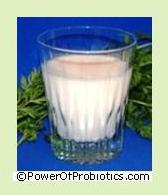Kefir? What is this "K" Stuff?
 |
Kefir (pronounced like “kee'fir” or "kay-fear' ") is traditionally a fermented milk drink that originated centuries ago. Cow, goat and sheep milk are usually used. However, in modern times you can buy or make kefir sugar water, coconut water, fruit juice or ginger beer. You can also use milk-alternatives such as soy milk, rice milk, hemp milk, coconut milk, sunflower seed milk, etc. |
As a cultured-milk beverage, it has a creamy texture to it, a mild yeasty aroma and a slightly sour taste. But don’t worry, it is not spoiled as regular spoiled milk would be. It is thicker and richer. Also, it can have some carbonation and a little bit of alcohol if left to ferment too long.
What Makes It Better Than Regular Milk?
Dairy kefir is made by combining fresh milk with the starter cultures of predominantly yeasts and lactic-acid bacteria. These cultures may have health-promoting benefits and some of the species used are probiotic species. The starter cultures can be in the form of a powder, also called “Dry Set Powder”, or in the form of “grains”. Each is discussed briefly below.
The Culture Powder
The powder is sold in packets. They are ideal for people who do not wish to make kefir regularly or who do not want to take care of the grains. For more information on the powder, a demonstration video of how to use it, and the cost savings involved, see this page of my site.
There are typically 7-9 strains of bacteria and yeasts in the powders. Typical microbes in the powder culture are the lactic-acid bacteria Lactococcus cremoris, Lactobacillus plantarum, the Streptococcus bacteria S. lactis, S. cremoris, S. diacelilactis, and a Saccharomyces yeast. The exact cultures will vary depending on the source.
A packet of powder is used to ferment one quart of milk, usually in 18-24 hours. Then, in a few days or less, a small amount (such as one-quarter cup) of the original quart is used to culture a second quart. And then a small amount of the second quart is used to culture a third quart, and so on. It is possible to culture a maximum of about eight quarts starting with one packet of culture.
The packets can be stored in the refrigerator or freezer until needed. I purchase mine from Body Ecology Products.
The “Grains”
Kefir grains are really not a grain. There is no wheat, barley, rye, oats, corn, rice, sorghum, etc. used in them, so they are low-carb and gluten free in nature. However, the facility they are grown in (and possibly dehydrated in) may process gluten-containing foods, so please always read ingredients and contact the manufacturer if you are unsure.
They are called “grains” because they look like rice grains. They can take on the appearance of cauliflower florets as they grow and multiply in liquid.
The grains come in two basic varieties: milk grains and water grains. Each is best suited for the liquid in which it grows. The grains I purchase from Cultures for Health are said to contain about 44 strains of microbes for the water grains and about 56 strains for the milk grains. Thus, there are more types of microbes in the grains than in the powders and this makes it possible for the microbes to form the cauliflower-like colonies.
The exact cultures will vary depending on the source and the fluid used in growing the grains. While cultures designed for use in cow, goat or sheep’s milk can usually be used to ferment other beverages, cultures specifically grown to ferment the other beverages will not grow well in the animal milks.
What are the Health Benefits of Kefir?
Since this cultured drink that falls in the “food” category, it is not meant to treat or cure any disease. As a result, no specific health claims are made for it. However, since it does contain numerous strains of lactic acid bacteria and yeasts, I believe that it belongs in a healthy lifestyle. Since it contains species of microbes that are classified as “probiotics”, regular consumption (to meet the “adequate numbers” criteria of the definition of probioitics) can help to keep the flora in your body more balanced and keep harmful microbes more under control.
For example, a 2005 study using kefir grains showed that cultured drink in vitro (in a lab dish) had greater antimicrobial activity than 5 antibiotics against the pathogens Streptococcus pyogenes, Staphylococcus aureus, Pseudomonas aeruginosa, and other pathogens.
Kefir is not just good for us. It's also been studied for use in aquaculture, the raising of fish, as in this study. Some fish are good sources of Omega-3 fatty acids and this cultured drink appeared to enhance those levels. The researchers concluded, "the fatty acid profile of flesh showed differences among the groups. The percentages of saturated fatty acid in the flesh lipid decreased, while 18:3n-3 and polyunsaturated fatty acids were increased at higher substitution levels of kefir grain. The present study showed that up to 100 g kg−1 supplementation of kefir in diets could be improve the fatty acid profile, especially PUFA, in fish flesh without adverse effect on the growth, feed utilization and survival rate of rainbow trout."
A larger number of strains of bacteria and yeasts in the grains may make them more beneficial to your health than the powders because it takes a village of microbes to be healthy, but I haven’t found any scientific studies documenting that the grains are absolutely better than the powders.
My suggestion is to decide which is best suited for your lifestyle, because if it’s a pain to make or take care of, you are less likely to continue using it. And if you really don’t want to make kefir at home, you can find several varieties already cultured in bottles at most natural health food stores. However, you can save a lot of money by making it at home as my article shows.
Other sources of probiotics are found on this page.
I research studies and share my clinical experience to write this free site to help you find solutions to your problems. As part of that, I recommend products and services that I genuinely believe will be of help to you. If you click on a link to a product/service, I may receive a small commission to support my efforts if you buy something. The item does not cost you more.
Thanks for visiting this site! If you've enjoyed reading this page or have found the information to be useful to you, please "like", tweet about it, or share it so others can benefit, too. You can leave comments below via Facebook or Disqus.
Comment with Disqus (including as a guest), Twitter or Google accounts:
If you are one of my many readers without a Facebook account, you can still comment.
Disclaimer: Please note: By law, I cannot provide any personalized recommendations for your specific health concern on this site. The information contained in this site is educational in nature and is not intended as diagnosis, treatment, prescription or cure for any physical or mental disease, nor is it intended as a substitute for regular medical care. Consult with your doctor regarding any health or medical concerns you may have.
Subscribe to my monthly newsletter and receive a free copy of "How to Use Probiotics to Lose Weight and Be Healthier".

To comply with the EU's GDPR data privacy regulation, please subscribe here:
Looking for some quality professional supplements, including probiotics? Check out my online dispensary, as I will be doing reviews of some of these products in the future. Click on the Fullscript picture. (Note: If you were a former Wellevate customer, please switch to Fullscript for a better customer experience. Thanks!)
Some competitors of SBI (Solo Build It) are posting fake negative reviews of SBI. If you are considering creating your own website business, or if you have a brick-and-mortar business but want an online presence, I highly recommend SBI!





Comment with Facebook!
I'd love to hear your opinion about what you just read. Leave me a comment in the box below! Other commenting options follow the Facebook comments.